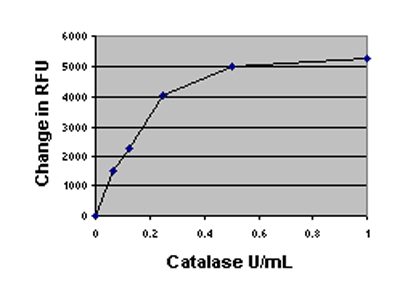GENTAUR - Research solutions for the academic, biotechnology and pharmaceutical industries
![]()
Fluoro Catalase™
Fluorescent Catalase Detection Kit
|
| Key Benefits: |
- Sensitive Fluorescent Assay.
- Enzyme Positive Control included in kit.
- Can monitor multiple time points to follow kinetics.
- One-step, No Wash assay.
- Adaptable for High Throughput format.
- Monitors enzymatic activity.
- Applications - Fluorescent Plate Reader.
|
| Assay Principle |
Catalase is an antioxidant enzyme that catalyses the decomposition of hydrogen peroxide (H202) to water and oxygen. Catalase is ubiquitously expressed in mammalian and non-mammalian aerobic cells containing the cytochrome system. The enzyme has been isolated from various sources, including bacteria and plant cells (1-3). Catalase activity varies greatly from tissue to tissue. Highest activity is seen in liver and kidney, while lowest activity is seen in connective tissue (3). In eukarotic cells, catalase in concentrated in organelles called peroxisomes (4).
The production of hydrogen peroxide in eukaryotic cells is an end product result of various oxidases and superoxide dismutase reactions. Accumulation of H202 can result in cellular damage through oxidation of proteins, DNA and lipids thus resulting in cell death and mutagenisis (8-11). H202 role in oxidative stress related diseases have been widely studied (8,12).
The Fluoro Catalase detection kit is sensitive assay that utilizes a non - fluorescent detection reagent to detect H202 substrate left over from the catalase reaction (5-6). |
| Reaction: |
H202 + catalase ----------> Water + oxygen

H202 (Left Over) + Detection reagent (non-fluorescent) + Peroxidase ---------> Resorufin (fluorescent)
Excitation 530-571
Emission 590-600nm |
Figure 1. Catalase activity was detected using the Fluoro Catalase kit.
The reaction contained 20uM H202 (final) per well and the indicated amounts of catalase in 1X reaction Buffer. The reaction was incubated for 30 minutes at room temperature.
Next 100uL of Reaction cocktail was added to each well and the reaction incubated for another 10 minutes in the dark at room temperature.
Fluorescence was measured at excitation 530nm and emission detected at 590nm.
The graph reports the change in fluorescence, observed fluorescence from negative control (no catalase) minus catalase sample fluorescence.
| Kit contents (for 500 assays) |
Description
|
Part#
|
Storage after opening Kit or
Reconstitution of Reagents. |
1 Bottle: 5X Reaction Buffer pH 7.4
|
3021 |
4-80C |
| 1 vial: Detection reagent |
4010
|
Undiluted : 4-80C
Diluted: Aliquot in single use vials: Below –200C |
| 1 vial: Horseradish Peroxidase |
6009 |
4-80C undiluted. Diluted: below –200C. |
| 1 vial: Hydrogen Peroxide |
3022 |
4-80C. |
| 1 vial: Catalase enzyme |
6008 |
Crystalline suspension: 4-80C |
|
|














